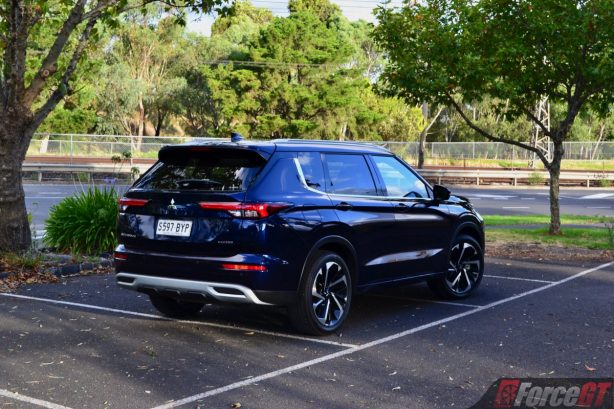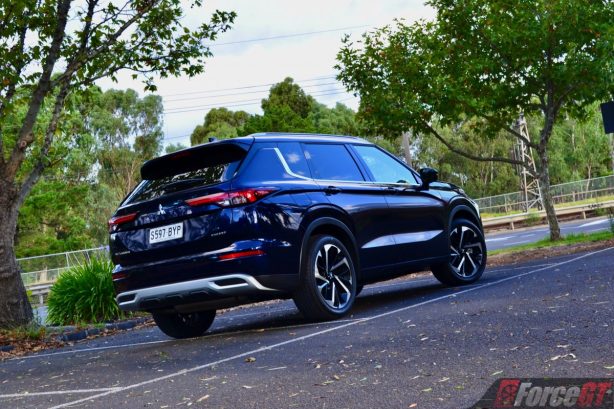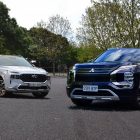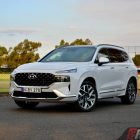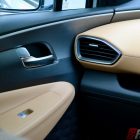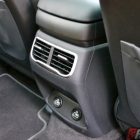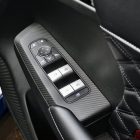There are proper full-size seven-seat SUVs and there are 5+2 ‘on-demand’ mid-size seven-seat SUVs. For those who think the former’s foot print is too big and the latter’s rear seats are too small, fortunately there is something in between. The Hyundai Santa Fe has been playing the game well for two generations now, appealing to those who are seeking a bridge between models like the larger Hyundai Palisade and smaller Hyundai Tucson.
Now there is a new challenger – well, sort of. The once mid-size Mitsubishi Outlander is now in its fourth generation, but it has grown so much in size over the years that it now plays in the medium-large SUV segment going up against the Santa Fe. Upsizing the Outlander was more of a strategy than coincidental, as it was part of Mitsubishi’s plan to make space for the Eclipse Cross – another ‘in-between’ SUV model bridging the Outlander and the compact ASX crossover.
While the Santa Fe is still a tickle larger than the Outlander (by a mere 75mm in length and 38mm in width, but 35mm lower), both cars have plenty of similarities. They are both seven seaters, available in either all-wheel drive or front-wheel drive forms, and powered by four-cylinder engines (V6 option is available in the Santa Fe).
Perhaps the biggest difference is in terms of price. The Santa Fe is priced from $45K to $66K, while the Outlander lands between $35K and $51K. This gives the Outlander a pretty good head start in this comparison.
For a fair shootout, we pitted the range topping Santa Fe Highlander diesel AWD against the high-spec Outlander Exceed AWD. We could have used the slightly pricier Outlander Exceed Tourer flagship but this model comes with massaging front seats amongst other goodies, which the Santa Fe Highlander lacks.
The Santa Fe Highlander diesel AWD is priced at $66,050, while the Outlander Exceed AWD asks $48,490. Both stickers exclude on-road costs.
On the outside
The fourth-gen Santa Fe has had a refresh in 2021, which gave the SUV a bold new front fascia with a wider grille that extends out to the headlamps. The front and rear bumpers have also been restyled, so did the taillights and wheels. Upper spec models like the Highlander have colour coded lower bumper and wheel arch cladding.
The Santa Fe has always looked the part with elegant lines, sculpted surfaces and classy details. The proportions are good, and the new split headlights and large grille lend it plenty of road presence. All exterior lightings are LEDs and the wheels are large 20-inch items.
If there was a prize for the biggest makeover of any recent new model, it would be certainly for the Outlander’s taking. Apart from the Mitsubishi corporate ‘Dynamic Shield’ front grille, the new Outlander has been totally redesigned from the ground up. And the result is stunning.
The new Outlander is a complete departure from its predecessor’s drab styling. There is now confidence and sophistication in its modern design. The front end really makes a statement with its heavy chrome highlight and a beefy bumper. The blacked-out A pillar is a neat touch and is no doubt a Nissan influence (stemming from Mitsubishi’s consolidation with the Nissan-Renault group). At the other end the floating roof styling continues the contemporary vibe, blending perfectly with the appropriately simplistic tailgate design.
LED lighting is used all around except for the turn indicators, and the 20-inch wheels are some of the best looking in an SUV from a mainstream brand.
Both the Santa Fe and Outlander are great looking SUVs, but the Mitsubishi design is undeniably the more striking of the pair.
On the inside
The Santa Fe’s interior has received several changes as part of the update. The most notable is the 12.3-inch full LCD instrument cluster, complemented by the upsized 10.25-inch widescreen infotainment touchscreen display on the dashboard. The centre console has also been revised, with the raised design mimicking that of its bigger brother, the Palisade. The redesigned steering wheel and door switches round up the changes.

Improved materials and lots of quilted Nappa leather give a whiff of luxury in the cabin, though we are not quite a fan of the tan leather for practical reasons. The contoured seats are wonderfully comfortable though, more so than those in the Outlander which are a bit square and less breathable.
In Highlander spec, the front seats have power adjustment, memory function, heating and cooling, while the rear outboard seats have heating. The steering wheel is also heated.

Like the exterior, the interior of the Outlander is a major step up from before. The design of the layered dashboard is clean, modern and functional. The materials are some of the best for a mainstream marque. There’s even textured diamond-shaped leather stitching on the seats and door cards, in a Mitsubishi!
For the first time, a full digital instrument cluster is employed in the Outlander. At 12.3-inch, it’s the same sized as that in the Santa Fe, though it serves up higher clarity graphics and is more customisable including a full map display in navigation mode.
The 9-inch infotainment touchscreen display is smaller than the Santa Fe’s, but it supports wireless CarPlay (wired only in the Santa Fe) which works fine if not a little laggy at times.
The Outlander Exceed matches the Santa Fe Highlander with leather appointed seats with power adjustment and memory function for the front seats. Seat cooling, heating for the rear outboard seats and heated steering wheel are not fitted though.
Both cars offer generous space for those seated in the front and second row seats. The third row seats are best left for kids or – if you must – adults for short trips. The Hyundai does afford more wiggle room in the back than the Mitsubishi, but it’s the latter that has a wider and easier access to the back seats.
With all seats up, the Outlander offers 163 litres of cargo space, more than the Santa Fe’s 130 litres. With the back seats folded, it’s the Santa Fe that carries more with 571 litres of space versus the Outlander’s 478 litres. The space can be further expanded in both SUVs by tumbling the second-row seats.
Both SUVs are closely matched in terms of safety. Essential features fitted include Lane Keep Assist, Blind Spot Monitoring, Rear Cross Traffic Alert, Forward and Reverse Collision Avoidance, Adaptive Cruise Control, Hill Start Assist and Automatic High Beam. Exclusive to the Hyundai is the Safe Exit Assist feature which warns the occupants of any approaching vehicle from behind when they attempt to open the door. Tow junkies will appreciate the Mitsubishi’s Trailer Stability Assist system.
Under the skin
Powering the Santa Fe Highlander is a 2.2-litre four-cylinder turbo diesel engine that produces 148kW at 3800rpm and 440Nm at 1750-2750rpm. Drive is channelled to the variable AWD system via an 8-speed dual-clutch automatic transmission.
This diesel engine has been around for a while now, but progressive updates over the years have improved its response, refinement and efficiency. On idle and when cruising, the oil burner is muted with barely a hint of clatter in the cabin. It only starts to get vocal at high revs.
But with that much torque low down in the rev range, there is hardly ever a need to work this thing, except when overtaking. The 8-speed DCT ensures quick gear changes with minimal power loss, further aiding power delivery of the strong diesel engine. And unlike some twin clutch boxes, the Hyundai wet friction DCT is not much of a fuss around slow-moving traffic, with no noticeable hesitation in first gear roll off. The ratios are well spaced to harvest the most out of the torquey diesel mill, too.
The Outlander range is solely motivated by a 2.5-litre four-cylinder normally aspirated petrol engine developing 135kW at 6000rpm and 245Nm at 3600rpm. It drives through an 8-stepped CVT automatic, with AWD models equipped with Mitsubishi’s touted and improved Super-All Wheel Control system (S-AWC).
The newly developed 2.5L petrol engine might lack a turbo and is down on both power and torque figures compared to the Santa Fe, but at no point did it feel weak on test. It’s partly attributed to the Outlander’s weight, which at 1760kg at the kerb is quite a bit lighter than the 1943kg Santa Fe.
Being petrol, response is sharper than the Santa Fe’s diesel, but even more impressive is the near premium level of refinement. It’s no doubt one of the quietest and smoothest powertrains in class.
And before you punters write off the CVT, we are glad it uses one because that’s the trick in continuously keeping the engine operating at its optimum power band while maximising fuel efficiency. The Outlander’s CVT stands out in such a way that it hardly flares the revs (and hence minimal elastic feel). The ratios are locked and stepped under hard acceleration to give a feel of connectedness, akin to the feel of a conventional torque converter box. It’s a brilliant combo with the engine.
On the road
Both SUVs are large vehicles, but on the road the size is not as noticeable as you would expect. They both feel a lot smaller to drive thanks to tight body control delivering composed handling. The Outlander edges ahead a little in handling response and turn-in, thanks to S-AWC braking individual wheels to help the car rotate in corners.
Around town the Santa Fe’s suspension tune is slightly softer, better ironing out irregularities at low speed. The tauter Outlander still rides smoothly for the most part, but some low speed high frequency bumps can transmit into the cabin.
Both vehicles triumph as a long distance cruiser in equal measure, with road and wind noise hardly audible. As for parking, the Outlander’s 75mm shorter length and tighter turning circle will make life easier.
In the long run
The Santa Fe comes with the standard warranty of 5 years, while the Outlander tops that with a warranty of 10 years when all services are completed at a Mitsubishi dealership. That said the Santa Fe warranty has no cap on kilometres while the Outlander’s is capped at 100,000km.
Both cars have identical servicing schedule, at 15,000km or 12 months, whichever comes first.
Both cars are offered with capped price servicing, with the Santa Fe capped at $419 per service for the first 5 years or 75,000km, and the Outlander asking just $199 for each dealer visit for the same time period or mileage. This makes the Mitsubishi quite a lot cheaper to maintain in the long term.
In terms of average fuel economy, the diesel powered Santa Fe is hands down the winner, rated at just 6.1L/100km as compared with the Outlander’s official figure of 8.1L/100km. But in the real world the figures are more closely matched, with the Santa Fe’s tested average of 8.0L/100km only slightly ahead of the Outlander’s 8.5L/100km.
Verdict
The Hyundai Santa Fe remains one of the best seven-seat SUVs on the market today. A complete package with style, space and comfort, backed by a gutsy and efficient diesel engine, there is little to fault in the Santa Fe.
Despite that, the Mitsubishi Outlander still manages to edge ahead, although only by a whisker. Such big a step up the Outlander has undergone in this iteration, it now plays at the top of its game with attractive styling, up-to-the-minute technology and a very admirable driving experience.
The Outlander might lack the outright grunt of the Santa Fe, it’s made up for in superior refinement, smoothness and handling.
Then there’s the price. The high spec Outlander Exceed model comes with all the bells and whistles at a very sharp price of $48k. The Santa Fe Highlander has a few more comfort features, but at $66k it just can’t beat the value proposition of the Mitsubishi.
And for that, the Outlander gets the recommendation over the Santa Fe.
| 2022 Hyundai Santa Fe Highlander Diesel AWD | 2022 Mitsubishi Outlander Exceed AWD | |
| Design and Comfort | 8.5 | 9.0 |
| Performance and Handling | 8.0 | 8.5 |
| Quality | 8.5 | 8.5 |
| Economy | 8.5 | 8.0 |
| Equipment and Features | 8.5 | 8.5 |
| Overall | 42/50 | 43/50 |
Pricing and Specification
| 2022 Hyundai Santa Fe Highlander Diesel AWD | 2022 Mitsubishi Outlander Exceed AWD | |
| Price (excluding on-road costs): | From $66,050 | From $48,490 |
| Warranty: | 5 years, unlimited km | 10 years, 100,000km |
| Warranty Customer Assistance: | 1 year roadside | 1 year roadside |
| Service Intervals: | 12 months, 15,000km | 12 months, 15,000km |
| Country of Origin: | South Korea | Japan |
| Engine: | 2.2-litre four-cylinder common rail direct injection turbo diesel: 148kW @ 3,800rpm, 440Nm @ 1,750-2,750rpm | 2.5-litre four-cylinder direct injection petrol: 135kW @ 6000rpm, 245Nm @ 3600rpm |
| Transmission: | 8-speed automatic dual clutch | CVT |
| Drivetrain: | All-wheel drive | All-wheel drive |
| Power-to-Weight Ratio (W/kg): | 77.9 | 78.3 |
| Combined Fuel Consumption (L/100km): | Claimed: 6.1/Tested: 8.0 | Claimed: 8.1/Tested: 8.5 |
| Fuel Capacity (L): | 67 | 55 |
| Body: | 5-door SUV, 7-seats | 5-door SUV, 7-seats |
| Safety: | 5-star ANCAP, 6 airbags, ABS, BA, EBD, ESC, Downhill Brake Control, Blind-Spot Collision-Avoidance Assist, Driver Attention Warning, Forward/Reverse Collision-Avoidance Assist, Lane Keeping Assist, Rear Cross-Traffic Collision-Avoidance Assist, Emergency Stop Signal, Tyre Pressure Monitoring System, Rear Occupant Alert, Safe Exit Assist, Surround View Monitor, ISOFIX | 5-star ANCAP, 7 airbags, ABS, BA, EBD, ESC, Downhill Brake Control, Blind-Spot Collision-Avoidance Assist, Driver Attention Warning, Forward/Reverse Collision-Avoidance Assist, Lane Keeping Assist, Rear Cross-Traffic Collision-Avoidance Assist, Emergency Stop Signal, Tyre Pressure Monitoring System, Rear Occupant Alert, Trailer Stability Assist, Surround View Monitor, ISOFIX |
| Dimensions (L/W/H/W-B): | 4,770/1,900/1,710/2,765 | 4,710/1,862/1,745/2,706 |
| Turning Circle Between Kerbs: | 11.4 | 10.6 |
| Kerb Weight (kg): | 1,900 | 1,760 |
| Entertainment: | 10.25-inch colour touchscreen, satellite navigation, AM/FM/DAB+, Bluetooth, USB, AUX, Apple CarPlay/Android Auto 10-speaker Infinity premium audio system | 9-inch colour touchscreen, satellite navigation, AM/FM/DAB+, Bluetooth, USB, AUX, Wireless Apple CarPlay/Android Auto 10-speaker Bose premium audio system |
 ForceGT.com Car News, Car Reviews, Video Reviews, Tuning and much more.
ForceGT.com Car News, Car Reviews, Video Reviews, Tuning and much more. 



